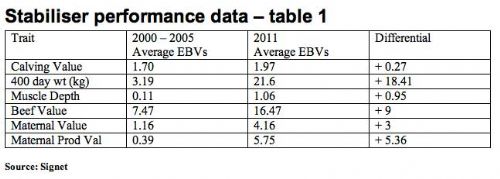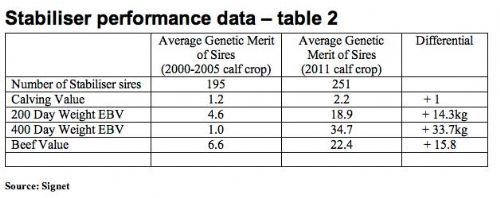
Access to an elite team of Stabiliser sires has had a major impact on the Stabiliser breed, according to Richard Fuller, technical director of the Stabiliser Cattle Company (SCC). He reports that Stabiliser breeders have significantly increased genetic gains for all recorded performance traits over the last six years.
’Beef Value has risen by 9 points, equivalent to 120%, while Maternal Value has gone up from 1.16 to 4.16. The average 400-day weight has gone up by 18.4kgs, from 3.19 to 21.6,’ explains Mr Fuller.
’Data recently produced by Signet has identified that many of these gains can be attributed to careful sire selection. The sires that produced the 2011 calf crop had the breeding potential to be 33kg heavier at 400 days of age, compared with those used between 2000 and 2005. Remarkably, they were also slightly easier calving,’ he adds.
’When selecting for growth and carcase traits, there is always the danger that it may be to the detriment of traits influencing calving ease. In the Stabiliser breed, it has proved not to be the case.’

Around 7,500 Stabiliser cows are recorded by Signet, making the breed one of the largest recorded populations in the UK, says Mr Fuller.
’Breeders are focused on improving maternal traits to increase cow performance, such as calving ease and calving interval, for today’s commercial market. However their other goal is to improve terminal sire traits, to increase the value of slaughter generations.
’Stabiliser breeders are very profit orientated and understand the significant economic benefits that higher animal performance adds to the bottom line. Performance recording of all pure Stabilisers is obligatory, and this requirement enables us to organise a breeding programme to deliver optimum and well balanced improvements in both maternal and terminal sire traits simultaneously. These advances are both cumulative and permanent.’
Samuel Boon, Signet manager comments:
’Sire selection isn’t just about terminal sire traits. Maternal EBVs, such as calving interval, milk production and lifespan, all play an important part in sire selection ’ as shown by the most dominant Stabiliser sire of 2011, Givendale Gold.
’Givendale Gold has 347 performance-recorded progeny, with EBVs that place him in the top 1% of the breed for calving, carcase and maternal traits, as assessed using the Signet breeding indexes Calving Value, Beef Value and Maternal Value.
’It is a challenge to identify balanced genetics like these within any breed and it is pleasing to see them being disseminated so widely for the benefit of Stabiliser breeders and their customers.’
To maintain the momentum of breed improvement, SCC is utilising the benefits of the EBLEX Young Bull Promotion Scheme (YBPS). The aim of the scheme is to promote the use of genetically superior young bulls across herds within any performance recorded breed.
Under the scheme, EBLEX provides financial support to breed societies, enabling the distribution of a limited number of semen straws from selected bulls. These are offered free of charge, to recorded breeders who wish to participate.
Currently, the SCC is promoting Givendale Louie through the YBPS. The exciting young prospect has one of the highest growth rates ever recorded within the Stabiliser breed, with a birth weight of 37kg. He weighed 750 kg at 400 days.
Mr Fuller says:
’Louie was imported from the USA as an embryo. He brings completely new bloodlines to our Stabiliser breeding programme over here. In the USA, the Stabiliser recording system dates back two decades and includes tens of thousands of animals, giving us a wide selection to choose from. There will be several other new bulls coming off test this year, and it will be interesting to see how their figures stack up against Louie’s.’
